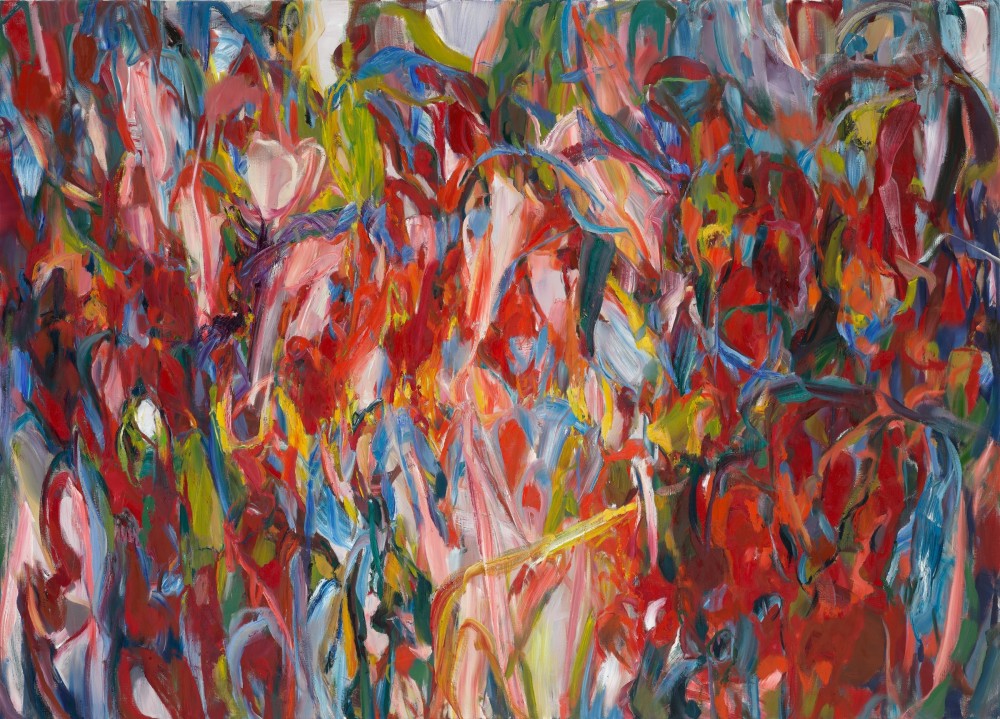
Sabine Moritz: Frost
In the studio, there is no time. All history is the present, and the present is history.
—Sabine Moritz
Gagosian is pleased to announce Frost, an exhibition of new abstract paintings by Sabine Moritz. This is the artist’s second exhibition with the gallery and her first on the West Coast.
Moritz’s paintings, drawings, and prints envision moments suspended in time. In her earlier work, the artist juxtaposes interpretations of her immediate surroundings and signifiers of the natural world with deconstructed documentary images; in many of her recent canvases, she adopts a more narrative approach, which she augments by using a horizontal format. Continually altering and deploying a wide range of abstract and symbolic motifs, Moritz explores the dynamics of transience and decay in works that locate personal experiences within broadly shared histories.
Since 2015, Moritz has increasingly worked in an abstract mode, creating paintings that she dubs “psychological landscapes,” titled after elements, locations, months, seasons, and mythological entities. In these works, overlapping brushstrokes are allied with chromatic contrasts in improvised compositions. Searching for primal sensory experience, Moritz avoids preliminary sketching, confronting the viewer instead with an unmediated dialogue between color and gesture that addresses recollection and history in a consciously oblique, ambiguous manner.
In the twenty new canvases on view in Beverly Hills, Moritz presents dense arrays of painterly marks that harness the emotional power of color while retaining a consistent visual rhythm. With titles that refer to time and place, and to poetry—And the lovers lie abed, with all their griefs in their arms (D. T.) (2024) is taken from Dylan Thomas’s ars poetica “In My Craft or Sullen Art,” from his 1946 collection Deaths and Entrances—the works repay extended looking. Moritz applies pigment vigorously and in layers, sometimes as impasto, which is then scraped back to imbue the surface with a varied texture. Engineering collisions between shape and hue, she sometimes also suggests figures emerging from or disappearing into the works’ interlocking patterns. This establishes references to artists of different epochs who have integrated the human form into landscape paintings. Like frost, which seems suspended between liquid and solid conditions, Moritz’s figures exist in an enigmatic liminal state.
Sabine Moritz’s paintings, drawings, and prints appear timeless yet endlessly shifting, each a suspended moment that explores the complex workings of memory. By situating observations of her immediate surroundings alongside deconstructed and de-historicized documentary images, and adapting and repurposing a catalogue of symbolic motifs, Moritz ponders the fragile constitution and mercurial dynamics of recollection. Both figurative and abstract, her works enhance our sensitivity to the passage of time, locating personal experience within shared narratives to examine ideas of transience and decay.
Moritz was born in 1969 in Quedlinburg, between Hannover and Leipzig, in East Germany. From 1973 to 1981, she lived in Lobeda, near Jena, also in East Germany. In 1985, a few years prior to the fall of the Berlin Wall, she immigrated with her family to Darmstadt, in West Germany. In 1988 she enrolled at the Hochschule für Gestaltung Offenbach (Offenbach University of Art and Design), where she studied under Adam Jankowski. From 1991 she continued her studies at the Kunstakademie Düsseldorf (Academy of Art Düsseldorf), initially under Markus Lüpertz, then under Gerhard Richter.
Between 1991 and 1992, Moritz produced Lobeda, a series of 149 large-scale monochrome pencil and charcoal drawings that remained unseen until 2009 when curator Hans Ulrich Obrist discovered them in her studio. Lobeda was published in 2010 by Buchhandlung Walther König and exhibited at the Kunsthaus sans titre, Potsdam, in 2011. The works depict everyday scenes from Moritz’s formative years in Lobeda and Neulobeda. A subsequent series, JENA Düsseldorf (2011), was inspired by a return visit to the area and derives additional imagery from the artist’s family photographs. It pictures Moritz’s memories of special moments, including her first day at school, as well as public sites that are significant to the region’s broader history.